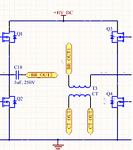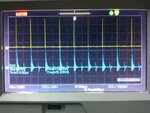renga92
Member level 5
Hi Everyone. I was able to try out all of the suggestion. Put the problem is still persisting. So I wanted to figure out if the current transformer output is a noise or it is really due to current flowing in the H bridge circuit. So I used the following circuit.

The two ends of the H bridge circuit which is connected to the SMPS isolation transformer was disconnected. Hence there is no path for current to flow through the current transformer and we expect 0V on the secondary of the CT. But this is what I got instead.

Yellow colored waveform corresponds to the MOSFET input waveform.
Blue colored waveform represents the current transformer secondary output.
The circuit used for the current transformer is as follows

I can't understand why I am getting this waveform from the CT when the current through them is zero. Signal amplitude is getting as high as 3V which is triggering my SMPS controller IC off, which could be observed from the yellow colored waveform having a short duty cycle in-spite of it being set at 50%. Can you help me to fix this problem.

The two ends of the H bridge circuit which is connected to the SMPS isolation transformer was disconnected. Hence there is no path for current to flow through the current transformer and we expect 0V on the secondary of the CT. But this is what I got instead.

Yellow colored waveform corresponds to the MOSFET input waveform.
Blue colored waveform represents the current transformer secondary output.
The circuit used for the current transformer is as follows

I can't understand why I am getting this waveform from the CT when the current through them is zero. Signal amplitude is getting as high as 3V which is triggering my SMPS controller IC off, which could be observed from the yellow colored waveform having a short duty cycle in-spite of it being set at 50%. Can you help me to fix this problem.


